NOT JUST FOR THE REFRIGERATOR
Art teachers are fighting the perception
that what they do is a frill.
They're making progress
by Jennifer Davis
Five minutes ago, 6-year-old Kemi
Arogundade was running around the
playground with her friends. Now
she's in Mrs. Kichinko's first-grade art
class at Springfield's Dubois Elementary School intently coloring her
lemon yellow "Mr. Sunshine."
|
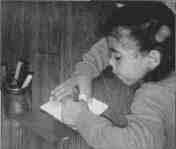
A student at Springfield's Dubois Elementary
School illustrates her own hook in art
class.
|
This "Mr. Sunshine" has purple eyes
with inch-long spiky eyelashes, a pert
nose and dangling earrings. Kemi
cocks her head, selects a blue crayon
and fills in the full lips. The colors she
has instinctively chosen vibrate
against each other, jumping off the
page. The dark daggers in the background, Kemi calmly explains, are
birds. The black streaks? Rain.
At her table, the other children chatter. They share crayons, critiques. But
Kemi is immersed in sweeping her arm
across the page. For her, it's obvious:
This is fun, but it's not play.
|
Arts educators nationwide are struggling against the perception that
Kemi's "Mr. Sunshine" is a frill,
nothing more than refrigerator art.
They've made great progress. Compared to the '80s with its "back to
basics" education movement, this
decade is a mini-renaissance for arts in
the classroom. There's money, research
and interest where there was none just
a few years ago.
|
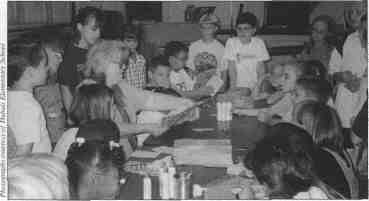
Dubois students get instruction from a visiting artist on how to make hooks.
|
The change is due in large part to a
1990 wake-up call that rallied art communities across the country. That year,
then-President George Bush and the
nation's governors announced national
educational goals, including a core
curriculum to be stressed through the
year 2000. The arts were absent. The
message couldn't have been more clear.
Arts educators issued an equally
clear response. Shortly after the arts
were overlooked, then-U.S. Secretary
of Education Lamar Alexander was
speaking in his home state of Tennessee. A school choir was scheduled
to perform, but the curtains parted to
reveal an empty stage. That embarrassing and deafeningly quiet moment
struck home. The arts are now
included in our national goals as essential subjects, along with English,
math, science, foreign languages, civics
and government, economics, history
and geography.
|
Still, the momentum from that
grass-roots effort hinges on what happens in the near future. Earlier this
year, a national sampling of eighth
30/ December 1997 Illinois Issues
grade students were tested in the arts
for the first time in two decades.
Preliminary results could be available
soon. Final results are expected next
spring. In Illinois, a statewide sampling of fourth-, seventh- and 11th-
graders were tested in the arts last
spring to get a baseline. A new,
improved test will examine another
sampling of students next spring.
|
Testing the arts, even on a small
scale, is a huge victory for arts education. "It's sad, but true. What gets
tested, gets taught," says Doug Herbert, director of arts education for the
National Endowment for the Arts.
Ironically, say some, arts education
may benefit more if our children do
poorly. Herbert recalls the American
public's shame when testing showed
our students didn't know basic geography. Increased attention resulted. So,
conversely, good test scores could
mean the arts will have to fight harder
to prove their worth.
|
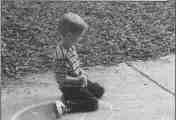
A side walk artist
|
It's a local battle. President Bill Clinton can praise the value of a well-
rounded education that includes the
arts. U.S. Secretary of Education
Richard Riley can say it's "at the heart
of education reform in the 1990s." Art
educators can say the arts teach creativity, problem solving and teamwork. But if local school boards don't
agree, that means nothing. Herbert
notes another motto in education that
many superintendents hold dear: "In
God we trust. Everybody else better
bring their data."
|
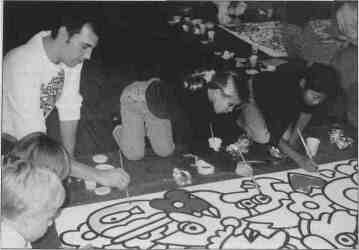
Artist Charles Houska helps students with a painting.
Six of the student paintings now grace the walls at Springfield's Dubois Elementary School.
|
The arts — dance, music, theater,
drawing and painting — are not
geared toward quantitative documentation. And, until recently, such
research didn't exist. "Proof that the
arts are important started to emerge in
the late '70s and '80s," says Nadine
Saitlin, executive director of the
Illinois Alliance for Arts Education.
"Prior to that, the arts were really
targeted as being a frill. In the '80s,
anything that didn't smack of the
three R's was considered irrelevant to
schooling."
Cam Davenport, fine arts coordinator for Springfield's District 186,
remembers that time. When he taught
art at Springfield's Lanphier High
School in the '70s, there were four fulltime art teachers. Then came the '80s
when there wasn't even one full-time
art instructor at the school. Today,
there is one full-time and one parttime instructor.
|
"Fifteen, 20 years ago, Springfield
used to have a string program," marvels Davenport. "It was an amazing
opportunity for kids who might not
otherwise have had that exposure. The
district even provided the instruments.
I came across them in an old middle
school shower room that's now used as
a storage area. I saw these beautiful
violins and cellos propped up against
these shower walls and heard this drip,
drip, drip. It was eerie and sad."
He pauses. "We still own a number
of them. I keep them, thinking someday we'll pull them out, fix them up
and use them." A longer pause. "That
may not be in my lifetime."
He sounds tired. Still, Davenport
does what he can. "I always tell new
art teachers, 'If you're not up to a constant struggle, don't come here.' It's
not enough to have knowledge about
how to teach the arts. You have to be a
strong advocate. I also tell them, 'We
can fight all day with administrators
and boards of education and not grow
an inch. Our best route is to be proactive and engage the community —
parents first.'"
Two months ago, Davenport and
about two dozen other representatives
of Springfield arts organizations tried
to rouse community interest with a
first-ever arts education roundtable.
They sat in the Masonic Temple basement, surrounded by propped-up art
Illinois Issues December 1997 /31
posters and pamphlet-laden card
tables and brainstormed with the
audience, a good-sized group of
parents, teachers and students. Mrs.
Kichinko, Kemi's teacher, was there.
The first obstacle mentioned? Money.
Mainly, the lack of it.
|
Schools don't have many options
when it comes to funding the arts.
They can allocate dollars in their base
budgets or apply for arts grants from
the Illinois Arts Council, a statewide
agency with a $14.1 million budget to
promote Illinois art. This year, the
council has about $650,000 to spend
on arts education statewide.
The Illinois State Board of Education also gives grants, but only to K-6
programs. This fiscal year $499,700 is
available. About $1.5 million was
requested. Still, it's a start. "For a
number of years, the state encouraged
schools to develop an arts curriculum," says Merv Brennan of the
state board. But only in the last decade
has the board backed that encouragement with cash.
|
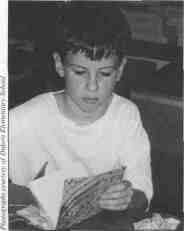
The students at Springfield's Duhois school learned
first how to make the paper
for their hooks.
|
There are no federal funds earmarked for arts education per se by the U.S. Department of Education,
but new Goals 2000 money — a significant chunk at $410 million this
past fiscal year — could help fulfill
arts-related goals. Schools have great
flexibility with that cash, says Sarah
Howe of the federal education department. The only hitch? Unlike other
federal education money, which is
automatically distributed under a formula, states have to apply for those
funds. Illinois got $16.6 million in
Goals 2000 money last fiscal year.
But, because schools could use those
dollars to address a variety of needs,
only the Tazewell Regional School
District specified an amount for arts
education: $28,225. Three other districts planned to use some of their
grant dollars for fine arts, but
amounts weren't specified.
|
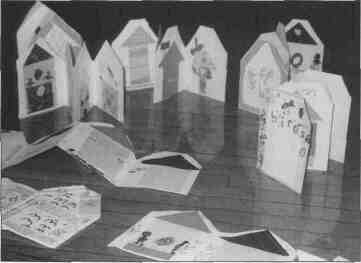
Then the students were allowed to give their imaginations free rein
in writing and illustrating their books. The students were guided by artist Nancy Vachon.
|
But money isn't everything. "If a
community wants arts education,"
says Joanne Vena, director of the arts
in education program at the Illinois
Arts Council, "they'll have it, regardless of the dollars."
The arts are a priority for Cliff
Hathaway, principal of Dubois,
Kemi's school. But Dubois is not
wealthy. Hathaway's office is a cubicle
pushed back into a corner — no real
walls or door. The school's 100-year-
old halls are beautiful. They're filled
with plants and children's drawings,
with painted popular cartoon
characters and photos of students
dancing. Hathaway went to school
here. "My first memory," he recalls,
"is of my mother walking me to
kindergarten, and my teacher was
there playing the piano."
|
In addition to Martha Kichinko,
Dubois' full-time art teacher, this
grade school continually brings in
guest artists. Two years ago, Charles
Houska helped the students paint six
large pieces that now grace the walls.
He himself painted a striking 50-foot
black-and-white mural that curves
across the school's library. And,
earlier this year, Nancy Vachon taught
the kids how to make paper, which
they then turned into books they
wrote and decorated. Fourth-grader
Sarah Spilker has fingerpainted the
cover of hers in purple and burnt
orange. A blue feather and some
sequins peek out from the inside,
which is filled with poems.
|
Night
lot of stars
shining brightly at night
hardly breathing at all
stars
|
For the past several years, Dubois
has used grant money to pay for those
guest artists. This year, for the first
32/ December 1997 Illinois Issues
time, the school's parent-teacher organization is picking up the $4,000-plus
tab.
The books the children made are a
good example of using the arts to
teach other subjects. That's something
Dubois strives to do on a daily basis.
On Hawaii Day, the fourth-graders
pretend to fly to that Pacific island,
and, once there, they learn to dance
the hula and make flower necklaces,
or"leis."
|
"They learn the culture, and it's
fun," says Mrs. Kichinko, who has
taught 30 years' worth of art students.
Until the Industrial Revolution,
the arts were integrated into every
subject, says Herbert of the NEA.
"Before the turn of the century, learning was a seamless whole," he explains.
"It was when we started putting
people on assembly lines that we
developed a penchant for compartmentalizing our curriculum. Really,
there is an affinity between the
scientist and the artist. Einstein knew
that."
Arts educators are now starting to
prove that link in a way that parents
can appreciate: research.
Musical instruction has been linked
to higher SAT scores, and related
research continues to surface. In February, another such study said musical
instruction results in increased spatial
reasoning. Chicago Public Schools
CEO Paul Vallas gave opening
remarks when the study's authors
visited Chicago two months later. He
said then that the arts "will not be
sacrificed on the altar of high
academic standards or on the altar of
other core curriculum subject areas."
|
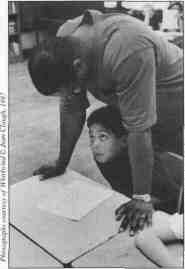
Whirlwind drama artist Little Tom Jackson gives
a student at Waters Elementary
School some personal attention.
|
In October, Whirlwind, a
Chicago-based group that uses drama
to teach the language arts, released a
study showing its students scored
significantly higher in reading and
reading comprehension than other
students who are not in the program.
Karl Androes, the program's executive director, spent almost 15 years
taking his music, drama and dance
company into schools. Then his son, a
third-grader, helped him see that the
arts could be used as a teaching tool.
|
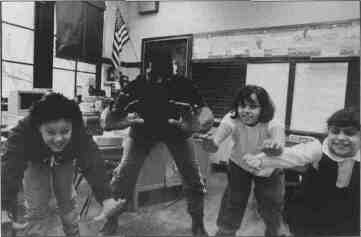
Jackson leads stretches with students at Pulaski
Community Academy
to warm up their bodies and imaginations.
|
"My son did really well in math in
second grade when there wasn't a lot
of reading attached to it. But in third
grade, suddenly everything — math,
science — involved reading. More and
more of his math was story problems,
which messed him up. Pretty soon he
felt like there was nothing he was good
at. It dawned on me that if our
children can't read, it doesn't matter if
they can dance. They need to get
through school to succeed in life.
Before, when we went into schools,
everybody had a good time and we all
went home. Now we're helping these
kids improve their basic skills."
Androes has discovered that kids
understand and remember stories
better when they act them out with his
drama troupe.
|
Indeed, fairly recent revolutionary
thinking in education shows that
students learn differently. Some
absorb information visually; others
kinesthetically. As artist Georgia
O'Keeffe once said, "I found that I
could say things with color and shapes
that I had no words for." The evolution in the way we approach and value
arts education has been slow, but it
has steadily gained steam in the past
decade.
For now, arts educators are holding
their collective breath, waiting for
those national test scores. Good or
bad, Kemi will still learn about the
arts as long as she's at Dubois. Her
school thinks it's important. Other
schools, however, might not, especially
if testing doesn't continue.
"We're preparing for either outcome," says Herbert. "We'll be ready
to defend ourselves."
Illinois Issues December 1997 /33







